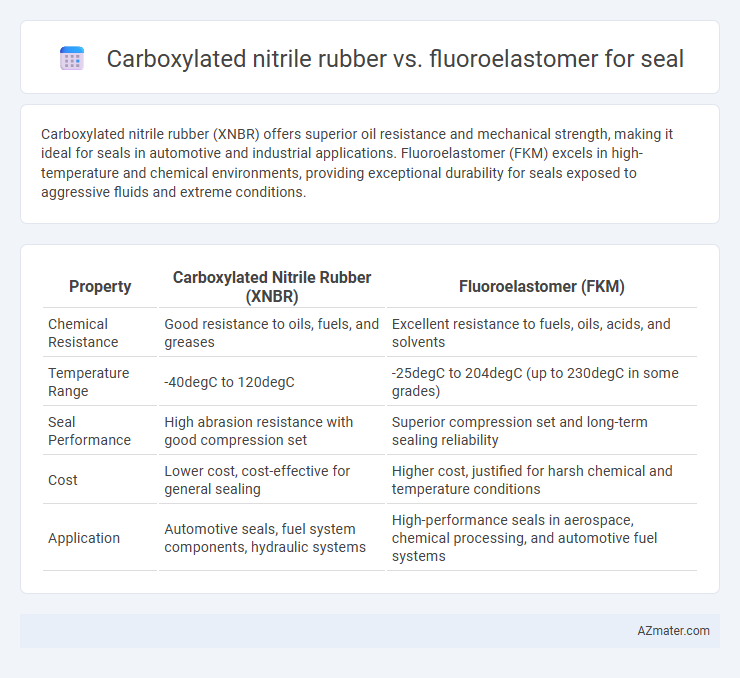Carboxylated nitrile rubber (XNBR) offers superior oil resistance and mechanical strength, making it ideal for seals in automotive and industrial applications. Fluoroelastomer (FKM) excels in high-temperature and chemical environments, providing exceptional durability for seals exposed to aggressive fluids and extreme conditions.
Table of Comparison
| Property | Carboxylated Nitrile Rubber (XNBR) | Fluoroelastomer (FKM) |
|---|---|---|
| Chemical Resistance | Good resistance to oils, fuels, and greases | Excellent resistance to fuels, oils, acids, and solvents |
| Temperature Range | -40degC to 120degC | -25degC to 204degC (up to 230degC in some grades) |
| Seal Performance | High abrasion resistance with good compression set | Superior compression set and long-term sealing reliability |
| Cost | Lower cost, cost-effective for general sealing | Higher cost, justified for harsh chemical and temperature conditions |
| Application | Automotive seals, fuel system components, hydraulic systems | High-performance seals in aerospace, chemical processing, and automotive fuel systems |
Introduction to Seal Material Selection
Carboxylated nitrile rubber (XNBR) offers excellent resistance to oils, fuels, and abrasion, making it a cost-effective choice for general-purpose sealing applications. Fluoroelastomers (FKM), known for superior chemical resistance, high-temperature stability up to 250degC, and exceptional weathering durability, are preferred in harsh environments involving aggressive chemicals and extreme temperatures. Selecting between XNBR and FKM depends on specific service conditions, including fluid compatibility, temperature range, and mechanical stress requirements crucial for reliable seal performance.
Overview of Carboxylated Nitrile Rubber (XNBR)
Carboxylated nitrile rubber (XNBR) is a high-performance elastomer known for enhanced tensile strength, abrasion resistance, and chemical resistance compared to standard nitrile rubber, making it suitable for demanding sealing applications. The presence of carboxyl groups in XNBR improves cross-linking density, resulting in superior mechanical properties and better oil, fuel, and solvent resistance. XNBR seals excel in dynamic conditions requiring durability and resilience against aggressive media, offering a cost-effective alternative to more expensive fluoroelastomers in certain industrial sealing environments.
Properties of Fluoroelastomer (FKM)
Fluoroelastomer (FKM) offers superior chemical resistance, particularly against fuels, oils, and aggressive solvents, making it ideal for seals in harsh environments. Its exceptional temperature stability spans from -26degC to 204degC, ensuring durability under extreme thermal conditions. FKM also exhibits excellent compression set resistance and mechanical strength, prolonging seal life and maintaining effective sealing performance.
Chemical Resistance: XNBR vs Fluoroelastomer
Carboxylated nitrile rubber (XNBR) offers excellent resistance to fuels, oils, and aliphatic hydrocarbons, making it suitable for sealing applications exposed to moderate chemical environments. Fluoroelastomers, such as FKM, provide superior chemical resistance against a broader range of aggressive fluids including aromatic hydrocarbons, ketones, esters, and strong acids, ensuring long-term durability in harsh chemical conditions. The enhanced resistance of fluoroelastomers makes them preferable for seals in demanding automotive, aerospace, and chemical processing industries where exposure to aggressive media is frequent.
Temperature Compatibility Comparison
Carboxylated nitrile rubber (XNBR) exhibits reliable temperature compatibility within the range of -40degC to 120degC, making it suitable for moderate thermal environments in sealing applications. Fluoroelastomers (FKM), however, offer superior thermal stability, maintaining seal integrity at extreme temperatures from -40degC up to 200degC or higher. The enhanced high-temperature resistance of fluoroelastomers positions them as the preferred choice for seals exposed to aggressive heat conditions and chemical environments.
Mechanical Strength and Wear Performance
Carboxylated nitrile rubber (XNBR) offers superior mechanical strength with enhanced tensile and tear resistance compared to standard nitrile, making it highly durable for seals under mechanical stress. Fluoroelastomers (FKM) excel in wear performance due to their exceptional chemical resistance and thermal stability, which reduces degradation and extends seal life in harsh environments. For applications demanding high mechanical strength combined with moderate wear resistance, XNBR is preferred, whereas FKM is optimal where chemical exposure and wear are critical factors.
Cost Analysis: XNBR versus FKM
Carboxylated nitrile rubber (XNBR) offers a cost-effective alternative to fluoroelastomer (FKM) seals, with raw material and processing expenses significantly lower than those of FKM. While XNBR provides good oil resistance and mechanical strength suitable for many sealing applications, FKM outperforms in chemical resistance and temperature stability, justifying its higher cost in demanding environments. Cost analysis reveals XNBR seals typically reduce overall production expenses by 20-40% compared to FKM, making XNBR economically advantageous for moderate sealing conditions.
Typical Industry Applications
Carboxylated nitrile rubber (XNBR) is commonly used for seals in automotive fuel systems and hydraulic equipment due to its excellent oil resistance and abrasion durability. Fluoroelastomer (FKM) seals are preferred in chemical processing, aerospace, and pharmaceutical industries for their superior resistance to high temperatures, aggressive chemicals, and solvents. Both materials offer reliable sealing solutions, but XNBR suits applications requiring moderate chemical exposure while FKM excels in extreme environments demanding high thermal stability and chemical inertness.
Longevity and Maintenance Considerations
Carboxylated nitrile rubber (XNBR) offers excellent resistance to oils and fuels, promoting durability in dynamic sealing applications, but it may degrade faster under extreme heat or aggressive chemicals compared to fluoroelastomers. Fluoroelastomers (FKM) exhibit superior longevity due to their outstanding chemical stability, high-temperature resistance up to 200degC, and excellent aging properties, significantly reducing maintenance intervals in harsh environments. Choosing between XNBR and FKM depends on operational conditions, with FKM seals typically requiring less frequent replacement and lower lifecycle costs in demanding applications.
Choosing the Right Seal Material for Your Needs
Carboxylated nitrile rubber (XNBR) offers excellent abrasion resistance and good oil and fuel compatibility, making it suitable for dynamic sealing applications in automotive and industrial environments with moderate chemical exposure. Fluoroelastomers (FKM) provide superior high-temperature stability, exceptional chemical resistance against aggressive fuels, oils, and solvents, and excellent weathering properties, ideal for seals operating in harsh chemical and thermal conditions. Selecting the right seal material depends on specific operational parameters such as temperature range, chemical exposure, mechanical stress, and cost considerations to ensure optimal performance and longevity.

Infographic: Carboxylated nitrile rubber vs Fluoroelastomer for Seal
 azmater.com
azmater.com